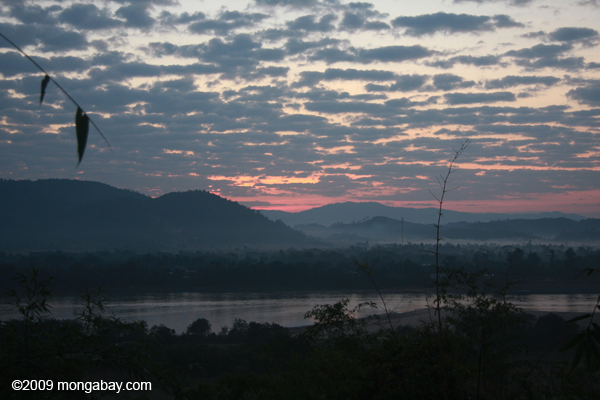
The Mekong River in Thailand. Photo by: Rhett A. Butler.
Laos has given approval to the hugely-controversial $3.5 billion Xayaburi Dam on the Mekong River, reports the BBC. The massive dam, which would provide 95 percent of its energy production to Thailand, has been criticized for anticipated impacts on the river’s fish populations, on which many locals depend.
In late 2011, the four Mekong River nations—Laos, Thailand, Vietnam, and Cambodia—announced that the dam would not go ahead until more research was conducted to allay concerns. Friction over the dam has created a rift between the Laos government and Thailand on the one side and Vietnam and Cambodia on the other, who fear the dam will hurt fish populations and river nutrients. The promised research has not come to light.
“The Xayaburi Dam is the first of a cascade of devastating mainstream dams that will severely undermine the region’s development efforts. The food security and jobs of millions of people in the region are now on the line,” Ame Trandem, Southeast Asia Program Director for the NGO International Rivers said in a press statement.
The U.S. State Department also raised concern about the approval, which will force the eviction of 2,100 local people.
“The extent and severity of impacts from the Xayaburi dam on an ecosystem that provides food security and livelihoods for millions are still unknown,” the State Department said in a statement, adding that they “hope” Laos will work with its neighbor before proceeding.
A recent study in Global Environmental Change found that if the 11 currently planned hydroelectric projects are built on the Mekong River, fish populations could fall by 16 percent. According to the paper, the “results suggest that basic food security is potentially at a high risk of disruption.”
But the Laos government, which hopes to see significant economic gain from the hydroelectric project, says that modifications to the dams design will allow fish and sediment to move freely through the dam.
But environmentalists also contend that the dam could result in the extinction of dozens of freshwater fish species, including the Mekong giant catfish (Pangasianodon gigas). Specimens of the Mekong giant catfish have been caught weighing up to 600 pounds (270 kilograms), but this monster fish has been overfished to the point of being listed as Critically Endangered by the IUCN Red List. Modifications to the dam may not large enough to benefit the Mekong giant catfish.
BBC reports that a ceremony will be held today as construction begins to move ahead full-steam. The date, November 7th, was selected to commemorate the anniversary of Russia’s Bolshevik Revolution.
Related articles
Mekong dam spree could create regional food crisis

(08/27/2012) Fish are a hugely important protein source for many people around the world. This is no more evident than along the lower Mekong River delta where an estimated 48 million people depend directly on the river for food and livelihoods. But now a new study in Global Environmental Change cautions that 11 planned hydroelectric dams in the region could cut vital fish populations by 16 percent while putting more strain on water and land resources.
Controversial Xayaburi dam in Laos officially suspended
(07/15/2012) Work on the controversial Xayaburi dam in the People’s Democratic Republic of Lao has been suspended, reports Reuters.
Photos: 208 species discovered in endangered Mekong region in 2010

(12/14/2011) Last year researchers scoured forests, rivers, wetlands, and islands in the vanishing ecosystems of the Mekong Delta to uncover an astounding 208 new species over a twelve month period. A new report by the World Wide Fund for Nature (WWF) highlights a number of the new species—from a new snub-nosed monkey to five new meat-eating pitcher plants to a an all-female, cloning lizard—while warning that many of them may soon be gone as the Mekong Delta suffers widespread deforestation, over-hunting and poaching, massive development projects, the destruction of mangroves, pollution, climate change, and a growing population.
Hydroelectric dam still a greenhouse gas source after 10 years
(11/01/2011) Hydroelectric power is often promoted as green energy, yet dams, especially in the tropics, can be significant sources of greenhouse gas emissions. When built, reservoirs trap vegetation, which, as it rots, emits both methane and carbon into the atmosphere. A new study in Science of the Total Environment found that a dam in Lao PDR remained a significant source of greenhouse gas emission even a decade after construction.
Opposition rises against Mekong dam as governments ponder decision

(04/13/2011) As the governments of Laos, Thailand, Cambodia, and Vietnam ready to meet on April 19th to decide whether or not to move forward on the Xayaburi Dam, critics of Mekong River hydroelectric project have warned that the dam will devastate freshwater biodiversity and impact the livelihoods of hundreds of thousands, if not more. Last month a coalition of 263 organizations from 51 countries released a letter in opposition of the dam’s construction.